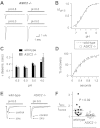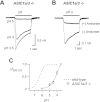Acid-sensing ion channels (ASICs) in mouse skeletal muscle afferents are heteromers composed of ASIC1a, ASIC2, and ASIC3 subunits
- PMID: 23109675
- PMCID: PMC3545527
- DOI: 10.1096/fj.12-220400
Acid-sensing ion channels (ASICs) in mouse skeletal muscle afferents are heteromers composed of ASIC1a, ASIC2, and ASIC3 subunits
Abstract
Acid-sensing ion channels (ASICs) are expressed in skeletal muscle afferents, in which they sense extracellular acidosis and other metabolites released during ischemia and exercise. ASICs are formed as homotrimers or heterotrimers of several isoforms (ASIC1a, ASIC1b, ASIC2a, ASIC2b, and ASIC3), with each channel displaying distinct properties. To dissect the ASIC composition in muscle afferents, we used whole-cell patch-clamp recordings to study the properties of acid-evoked currents (amplitude, pH sensitivity, the kinetics of desensitization and recovery from desensitization, and pharmacological modulation) in isolated, labeled mouse muscle afferents from wild-type (C57BL/6J) and specific ASIC(-/-) mice. We found that ASIC-like currents in wild-type muscle afferents displayed fast desensitization, indicating that they are carried by heteromeric channels. Currents from ASIC1a(-/-) muscle afferents were less pH-sensitive and displayed faster recovery, currents from ASIC2(-/-) mice showed diminished potentiation by zinc, and currents from ASIC3(-/-) mice displayed slower desensitization than those from wild-type mice. Finally, ASIC-like currents were absent from triple-null mice lacking ASIC1a, ASIC2a, and ASIC3. We conclude that ASIC1a, ASIC2a, and ASIC3 heteromers are the principle channels in skeletal muscle afferents. These results will help us understand the role of ASICs in exercise physiology and provide a molecular target for potential drug therapies to treat muscle pain.
Figures






Similar articles
-
The expression profile of acid-sensing ion channel (ASIC) subunits ASIC1a, ASIC1b, ASIC2a, ASIC2b, and ASIC3 in the esophageal vagal afferent nerve subtypes.Am J Physiol Gastrointest Liver Physiol. 2014 Nov 1;307(9):G922-30. doi: 10.1152/ajpgi.00129.2014. Epub 2014 Sep 4. Am J Physiol Gastrointest Liver Physiol. 2014. PMID: 25190475 Free PMC article.
-
ASIC2a and ASIC3 heteromultimerize to form pH-sensitive channels in mouse cardiac dorsal root ganglia neurons.Circ Res. 2009 Jul 31;105(3):279-86. doi: 10.1161/CIRCRESAHA.109.202036. Epub 2009 Jul 9. Circ Res. 2009. PMID: 19590043 Free PMC article.
-
Acid Sensing Ion Channel 1a (ASIC1a) Mediates Activity-induced Pain by Modulation of Heteromeric ASIC Channel Kinetics.Neuroscience. 2018 Aug 21;386:166-174. doi: 10.1016/j.neuroscience.2018.06.033. Epub 2018 Jun 30. Neuroscience. 2018. PMID: 29964154
-
Peptides inhibitors of acid-sensing ion channels.Toxicon. 2007 Feb;49(2):271-84. doi: 10.1016/j.toxicon.2006.09.026. Epub 2006 Oct 4. Toxicon. 2007. PMID: 17113616 Review.
-
ASICs and cardiovascular homeostasis.Neuropharmacology. 2015 Jul;94:87-98. doi: 10.1016/j.neuropharm.2014.12.017. Epub 2015 Jan 12. Neuropharmacology. 2015. PMID: 25592213 Free PMC article. Review.
Cited by
-
Histidine Residues Are Responsible for Bidirectional Effects of Zinc on Acid-Sensing Ion Channel 1a/3 Heteromeric Channels.Biomolecules. 2020 Sep 2;10(9):1264. doi: 10.3390/biom10091264. Biomolecules. 2020. PMID: 32887365 Free PMC article.
-
ASIC3 plays a protective role in delayed-onset muscle soreness (DOMS) through muscle acid sensation during exercise.Front Pain Res (Lausanne). 2023 Sep 19;4:1215197. doi: 10.3389/fpain.2023.1215197. eCollection 2023. Front Pain Res (Lausanne). 2023. PMID: 37795390 Free PMC article.
-
Characteristics of acid-sensing ion channel currents in male rat muscle dorsal root ganglion neurons following ischemia/reperfusion.Physiol Rep. 2023 Mar;11(6):e15654. doi: 10.14814/phy2.15654. Physiol Rep. 2023. PMID: 36967457 Free PMC article.
-
Properties and Differential Expression of H+ Receptors in Dorsal Root Ganglia: Is a Labeled-Line Coding for Acid Nociception Possible?Front Physiol. 2021 Oct 26;12:733267. doi: 10.3389/fphys.2021.733267. eCollection 2021. Front Physiol. 2021. PMID: 34764880 Free PMC article. Review.
-
The expression profile of acid-sensing ion channel (ASIC) subunits ASIC1a, ASIC1b, ASIC2a, ASIC2b, and ASIC3 in the esophageal vagal afferent nerve subtypes.Am J Physiol Gastrointest Liver Physiol. 2014 Nov 1;307(9):G922-30. doi: 10.1152/ajpgi.00129.2014. Epub 2014 Sep 4. Am J Physiol Gastrointest Liver Physiol. 2014. PMID: 25190475 Free PMC article.
References
Publication types
MeSH terms
Substances
Grants and funding
LinkOut - more resources
Full Text Sources
Other Literature Sources

